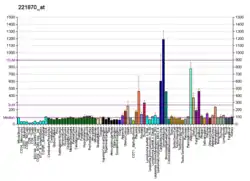EHD2
EH-domain containing 2, also known as EHD2, is a human gene[5] belonging to the EHD protein family.
References
- GRCh38: Ensembl release 89: ENSG00000024422 - Ensembl, May 2017
- GRCm38: Ensembl release 89: ENSMUSG00000074364 - Ensembl, May 2017
- "Human PubMed Reference:". National Center for Biotechnology Information, U.S. National Library of Medicine.
- "Mouse PubMed Reference:". National Center for Biotechnology Information, U.S. National Library of Medicine.
- "Entrez Gene: EHD2 EH-domain containing 2".
Further reading
- Pohl U, Smith JS, Tachibana I, et al. (2000). "EHD2, EHD3, and EHD4 encode novel members of a highly conserved family of EH domain-containing proteins". Genomics. 63 (2): 255–62. doi:10.1006/geno.1999.6087. PMID 10673336.
- Strausberg RL, Feingold EA, Grouse LH, et al. (2003). "Generation and initial analysis of more than 15,000 full-length human and mouse cDNA sequences". Proc. Natl. Acad. Sci. U.S.A. 99 (26): 16899–903. doi:10.1073/pnas.242603899. PMC 139241. PMID 12477932.
- Guilherme A, Soriano NA, Bose S, et al. (2004). "EHD2 and the novel EH domain binding protein EHBP1 couple endocytosis to the actin cytoskeleton". J. Biol. Chem. 279 (11): 10593–605. doi:10.1074/jbc.M307702200. PMID 14676205.
- Ota T, Suzuki Y, Nishikawa T, et al. (2004). "Complete sequencing and characterization of 21,243 full-length human cDNAs". Nat. Genet. 36 (1): 40–5. doi:10.1038/ng1285. PMID 14702039.
- Park SY, Ha BG, Choi GH, et al. (2004). "EHD2 interacts with the insulin-responsive glucose transporter (GLUT4) in rat adipocytes and may participate in insulin-induced GLUT4 recruitment". Biochemistry. 43 (23): 7552–62. doi:10.1021/bi049970f. PMID 15182197.
- Aboulaich N, Vainonen JP, Strålfors P, Vener AV (2005). "Vectorial proteomics reveal targeting, phosphorylation and specific fragmentation of polymerase I and transcript release factor (PTRF) at the surface of caveolae in human adipocytes". Biochem. J. 383 (Pt 2): 237–48. doi:10.1042/BJ20040647. PMC 1134064. PMID 15242332.
- Guilherme A, Soriano NA, Furcinitti PS, Czech MP (2004). "Role of EHD1 and EHBP1 in perinuclear sorting and insulin-regulated GLUT4 recycling in 3T3-L1 adipocytes". J. Biol. Chem. 279 (38): 40062–75. doi:10.1074/jbc.M401918200. PMID 15247266.
- Beausoleil SA, Jedrychowski M, Schwartz D, et al. (2004). "Large-scale characterization of HeLa cell nuclear phosphoproteins". Proc. Natl. Acad. Sci. U.S.A. 101 (33): 12130–5. doi:10.1073/pnas.0404720101. PMC 514446. PMID 15302935.
- Ballif BA, Villén J, Beausoleil SA, et al. (2005). "Phosphoproteomic analysis of the developing mouse brain". Mol. Cell. Proteomics. 3 (11): 1093–101. doi:10.1074/mcp.M400085-MCP200. PMID 15345747.
- Gerhard DS, Wagner L, Feingold EA, et al. (2004). "The status, quality, and expansion of the NIH full-length cDNA project: the Mammalian Gene Collection (MGC)". Genome Res. 14 (10B): 2121–7. doi:10.1101/gr.2596504. PMC 528928. PMID 15489334.
- Olsen JV, Blagoev B, Gnad F, et al. (2006). "Global, in vivo, and site-specific phosphorylation dynamics in signaling networks". Cell. 127 (3): 635–48. doi:10.1016/j.cell.2006.09.026. PMID 17081983. S2CID 7827573.
External links
- Overview of all the structural information available in the PDB for UniProt: Q8BH64 (Mouse EH domain-containing protein 2 (EHD2)) at the PDBe-KB.
This article is issued from Wikipedia. The text is licensed under Creative Commons - Attribution - Sharealike. Additional terms may apply for the media files.






